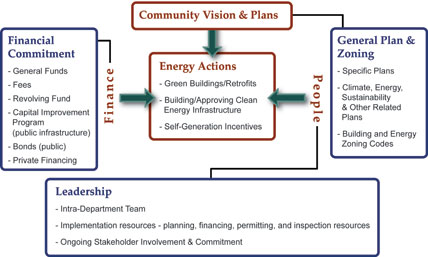Viewpoint: Taking action toward sustainability — Energy tactics and strategies for tough times

While the current fiscal crisis and limited growth hamper government investment in energy efficiency and sustainability programs, many cities and counties are nevertheless implementing economical programs to continue progress toward their environmental goals. Cities and counties can use low-cost tactics and strategies to build and maintain momentum in their energy efficiency programs.
1. Pass green building codes.
Improving the energy efficiency of new construction is critical to meeting climate and energy goals. One of the most cost-effective steps that cities and counties can take is to pass building codes, which set energy efficiency standards that exceed present state codes for new and remodeled buildings. More than 200 communities have enacted such codes over the past five years. This step is effective because about 40 percent of all energy used in cities powers buildings, according to the Washington-based U.S. Green Building Council. Research by SAIC suggests that building energy use must be reduced by 60 percent by 2050 from 2005 levels if the country is to achieve its overall greenhouse gas reduction goal of 80 percent, as set by the U.S. Environmental Protection Agency and the California Air Resources Board.
Local governments can write, pass and implement green building codes at a minimal expense by reviewing other jurisdictions’ green building code language, application checklists, and other permitting and enforcement procedures. Energy efficiency requirements can be integrated into permit and inspection processes at no or often minimal additional expense to the agency and its applicants. For builders and property owners, additional costs are usually quickly recovered in energy savings.
2. Cost-effectively finance energy efficiency.
Local governments commonly have financing challenges when developing energy efficiency programs for their own buildings. Difficulties include limited availability of affordable financing, limits on credit and the potential negative effect on credit ratings. To address those issues, local governments are experimenting with self financing, including revolving funds, and third-party financing, often through performance contracts offered by energy service companies. Also, local governments may be able to tap utility programs that allow them to borrow funds at very low or zero interest through ratepayer-funded or on-bill financing programs, as is allowed in California.
Ann Arbor, Mich.; San Jose, Calif.; and Nashua, N.H., have set up revolving funds to finance energy projects and create financially self-sustaining energy offices. San Jose set up a revolving fund in 2007 of $200,000 with utility rebate funds from a traffic signal LED installation. The fund allows the city’s energy office to retain the first two years of energy bill savings (plus rebate amounts) as capital for future energy efficiency projects and retain a dedicated city facilities energy officer. At present, that investment has generated close to $200,000 and is expected to almost double because of the use of the city’s American Recovery and Reinvestment Act (ARRA) Energy Efficiency and Conservation Block Grant Funds for additional retrofit projects.
Nashua’s fund obtains monies from local banks to supplement its own funds. Its energy office provides loans to departments at 5 percent interest, which must be paid back within five years. After the payback period, the departments retain all of the savings over the life of the equipment.
For local governments helping small businesses and residences finance energy efficiency or solar projects, the federal home mortgage agencies’ reluctance to allow Property Assessed Clean Energy (PACE) loans puts a crimp on property tax-based financing. Despite that set back, cities and counties are piloting innovative financing approaches to support retrofits. One such program already has financed retrofits for about 500 Portland, Ore., homes and is being used as a model for a similar program in Seattle, called Clean Energy Works. The program pays for energy efficiency improvements through 20-year loans, which homeowners repay through their utility bills. That type of on-bill financing approach, possibly backed by banks, may help provide options to homeowners.
3. Establish a sustainable energy enterprise framework.
To advance energy and sustainability agendas in tough times, cities and counties should act both tactically and strategically. Many communities can accomplish the basic tactical suggestions provided above in the short term. A key strategic goal for local governments should be to develop a business model for energy and sustainability programs that will support activities through harsh economic times and better prepare cities and counties for future downturns.
SAIC developed the Sustainable Energy Enterprise framework (see Figure 1) based on successful strategies used in communities around the country, such as in San Jose.
Fig. 1

The Sustainable Energy Enterprise framework is based on three key practices:
1. strong political, civic and executive leadership that creates a vision for the future;
2. well-crafted strategic plans that leverage communities’ land use and development authority; and
3. a financial model that provides resources over the long term.
Local governments can develop a financial model that will support energy functions and offices by planning services and projects in a way that creates a stream of cash. Those services may include creating revolving funds to finance energy projects, developing fee-for-service energy efficiency assessment and implementation services, and administering community loan programs like those in Portland, Ore.; Berkeley, Calif.; and Palm Desert, Calif.
By taking those steps, cities and counties can cost-effectively build or maintain momentum for their energy and sustainability programs.
Thomas Jensen is a practice director at SAIC with more than 20 years of experience in business, technology, and market strategy and planning; economic analysis; public-private partnerships; and energy, environmental, and sustainability management. He can be reached at [email protected].
Related Stories
What do you think? Tell us in the comment box below.




















